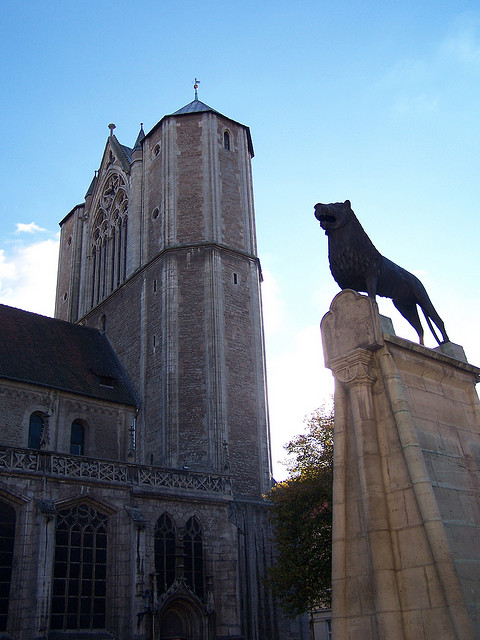Contemporary Church History Quarterly
Volume 21, Number 2 (June 2015)
Letter from the Editors (June 2015)
By Kyle Jantzen, Ambrose University
Dear Friends,
Once again this quarter we’re delighted to offer you a diverse collection of reviews and other contributions relating to twentieth-century German and European religious history. The trend at Contemporary Church History Quarterly is that we’re regularly branching out beyond our core interests in German church history to include diverse developments from across Europe.

Braunschweig Cathedral with the heraldic lion of Henry the Lion, Duke of Saxony and of Bavaria. Photo (cc) via Flickr user Hühnerauge: https://flic.kr/p/4STUtJ
In this issue, guest contributor William Doino Jr. has written an overview of recent research on Pope Pius XII’s wartime efforts to rescue Jews. Doino Jr. assesses a number of recent publications from Italy, where scholars have unearthed a variety of primary sources which argue in favour of Pius XII in the so-called “Pius Wars.” His article includes many links to further information on these publications, enabling readers to make their own assessments about the current state of the Italian branch of Pius scholarship.
Our reviews begin with Christopher Probst evaluating Alon Confino’s A World Without Jews: The Nazi Imagination from Persecution to Genocide. We think this is an important book for our readers to know about, since as Roger Morgan explained in Times Higher Education, Confino argues “that the main reason why the Holocaust happened lay not in a basically racialist anti-Semitic ideology, nor (in the end) in the momentum of a banal extermination machinery, but rather with Hitler’s quasi-religious obsession with annihilating the entire tradition and memory of Jewishness, from the Old Testament onwards, as a force antithetical to Christianity as well as to Nazism.” Such an interpretation thrusts religion back into the centre of our ongoing consideration of the Holocaust, which is, as Probst maintains, important.
Andrew Chandler and John S. Conway have written three fine reviews of intriguing books on twentieth-century Britain: David Nash’s Christian Ideals in British Culture: Stories of Belief in the Twentieth Century, Andrew Atherstone and John Maiden’s Evangelicalism and the Church of England in the Twentieth Century: Reform, Resistance and Renewal, and Timothy Jones’ Sexual Politics in the Church of England 1857-1957. Finally, John S. Conway alerts us to a little book with a big message: Rainer Stuhlmann’s Zwischen den Stühlen: Alltagsnotizen eines Christen in Israel und Palästina, which describes the work of the Northern Israeli Christian community Nes Ammim to bridge the social and religious divide between Israelis and Palestinians.
Our last contribution in this issue is a description of an interesting new article by the late Friedrich Weber and Charlotte Methuen concerning church building in Braunschweig during the Nazi era. The Braunschweig Cathedral (here pictured) was an important site of this ideological interplay between National Socialism and Christianity.
With apologies to our readers in the Southern Hemisphere, let me wish the rest of you a wonderful summer, as the days grow longer,the temperatures warmer, and (hopefully!) the schedule lighter.
On behalf of the other editors,
Kyle Jantzen, Ambrose University
